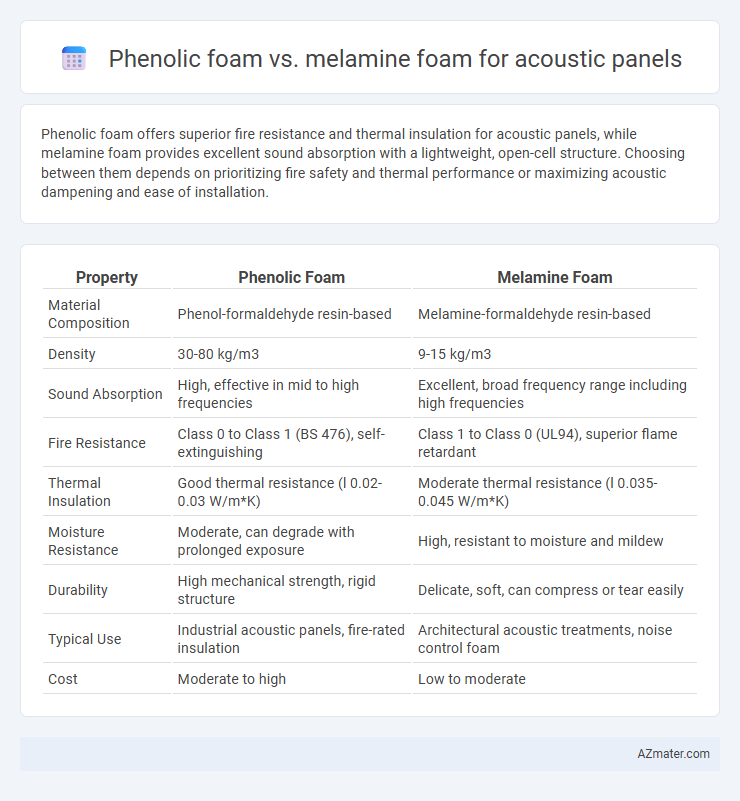Phenolic foam offers superior fire resistance and thermal insulation for acoustic panels, while melamine foam provides excellent sound absorption with a lightweight, open-cell structure. Choosing between them depends on prioritizing fire safety and thermal performance or maximizing acoustic dampening and ease of installation.
Table of Comparison
| Property | Phenolic Foam | Melamine Foam |
|---|---|---|
| Material Composition | Phenol-formaldehyde resin-based | Melamine-formaldehyde resin-based |
| Density | 30-80 kg/m3 | 9-15 kg/m3 |
| Sound Absorption | High, effective in mid to high frequencies | Excellent, broad frequency range including high frequencies |
| Fire Resistance | Class 0 to Class 1 (BS 476), self-extinguishing | Class 1 to Class 0 (UL94), superior flame retardant |
| Thermal Insulation | Good thermal resistance (l 0.02-0.03 W/m*K) | Moderate thermal resistance (l 0.035-0.045 W/m*K) |
| Moisture Resistance | Moderate, can degrade with prolonged exposure | High, resistant to moisture and mildew |
| Durability | High mechanical strength, rigid structure | Delicate, soft, can compress or tear easily |
| Typical Use | Industrial acoustic panels, fire-rated insulation | Architectural acoustic treatments, noise control foam |
| Cost | Moderate to high | Low to moderate |
Introduction to Acoustic Panels
Acoustic panels made from phenolic foam offer superior thermal insulation and fire resistance, making them ideal for environments requiring stringent safety standards. Melamine foam panels excel in sound absorption due to their open-cell structure, providing effective noise reduction and reverberation control. Selecting the appropriate foam type depends on specific acoustic performance requirements, including fire ratings and environmental conditions.
Overview of Phenolic Foam
Phenolic foam is a rigid, closed-cell insulation material known for its excellent fire resistance, low smoke emission, and superior thermal insulation properties, making it ideal for acoustic panels in safety-critical environments. Its dense structure effectively absorbs and dampens sound waves, enhancing noise reduction performance compared to more porous materials like melamine foam. Phenolic foam's durability and dimensional stability under varying temperatures contribute to its preference in commercial and industrial acoustic applications.
Overview of Melamine Foam
Melamine foam is a lightweight, open-cell material known for its excellent sound absorption properties, making it highly effective in acoustic panels compared to phenolic foam. Its porous structure provides superior noise reduction across a broad frequency range, while also offering fire resistance and thermal insulation. Melamine foam's versatility in density and thickness allows for tailored acoustic solutions in both commercial and residential environments.
Sound Absorption Properties Comparison
Phenolic foam exhibits excellent sound absorption properties due to its open-cell structure, which effectively dissipates sound waves and reduces reverberation in acoustic panels. Melamine foam also offers high sound absorption, particularly at mid to high frequencies, thanks to its lightweight, porous nature that traps and scatters sound energy. Comparing the two, phenolic foam typically provides better thermal resistance and higher sound absorption in lower frequency ranges, while melamine foam excels in broadband noise reduction and flame retardancy for diverse acoustic environments.
Fire Resistance: Phenolic vs Melamine Foam
Phenolic foam exhibits superior fire resistance compared to melamine foam, with a higher limiting oxygen index (LOI) typically around 35-45%, indicating greater difficulty in ignition and combustion. Melamine foam offers moderate fire resistance, with an LOI usually between 28-35%, and can char rather than burn, providing some self-extinguishing properties. For acoustic panels requiring stringent fire performance, phenolic foam is often preferred due to its low smoke emission and enhanced thermal stability under high temperatures.
Durability and Longevity
Phenolic foam offers superior durability and longevity compared to melamine foam due to its rigid cellular structure and higher resistance to heat, moisture, and compression, making it ideal for long-lasting acoustic panels in demanding environments. Melamine foam, while effective for sound absorption, is more prone to mechanical damage and degradation over time when exposed to physical stress and environmental factors. Phenolic foam's robust chemical composition contributes to its extended lifespan, maintaining acoustic performance with minimal maintenance.
Environmental and Health Considerations
Phenolic foam and melamine foam differ significantly in environmental and health impacts when used for acoustic panels. Phenolic foam contains formaldehyde and phenol, which may off-gas volatile organic compounds (VOCs) posing health risks during installation and use, while melamine foam is generally free of formaldehyde and exhibits lower VOC emissions. Melamine foam is more biodegradable and easier to recycle, making it a preferable choice for environmentally conscious applications focused on reducing indoor air pollution and toxic exposure.
Cost Analysis
Phenolic foam offers a cost-effective solution for acoustic panels, with prices generally lower than melamine foam while maintaining good thermal insulation and fire resistance. Melamine foam, though more expensive, provides superior sound absorption and flame retardant properties, justifying the higher investment for high-performance acoustic applications. When budgeting for acoustic paneling, the choice between phenolic and melamine foam depends on prioritizing cost efficiency or advanced acoustic and fire safety performance.
Installation and Maintenance
Phenolic foam acoustic panels offer easy installation with lightweight properties and can be cut or shaped on-site without significant dust or debris, making them suitable for quick setups. Melamine foam panels also provide simple installation, but require careful handling due to their fragile, open-cell structure that can crumble if improperly cut or mounted. Maintenance for phenolic foam involves minimal effort as it resists moisture and mold, while melamine foam may need more frequent cleaning and protection from damage to preserve its acoustic performance over time.
Best Applications and Recommendations
Phenolic foam excels in fire resistance and thermal insulation, making it ideal for acoustic panels in industrial and commercial buildings where stringent fire safety standards are required. Melamine foam offers superior sound absorption and is best suited for office spaces, recording studios, and residential environments needing effective noise reduction with lightweight material. For applications prioritizing fire retardancy and structural integrity, phenolic foam is recommended, while melamine foam is preferred for enhanced acoustic comfort and ease of installation.

Infographic: Phenolic foam vs Melamine foam for Acoustic panel
 azmater.com
azmater.com